Wii-View Part One: The Looks
This is part one of my four part review of the new Nintendo Wii ("We"). It's the first video game console I've owned since my mom bought my brother and I a Nintendo 64 in 1996. Gameboys have served as a bridge, but this is my official return to the Nintendo console galaxy. These are my thoughts.
The Wii's design is simple, small, and clean. Size-wise, it's been compared to the size of about 3 DVD cases stacked on top of one another. It can be positioned either sitting flat, like an external DVD drive would next to your computer, or positioned vertically on the included stand. It comes in white, but I've read that they will be releasing them in other colors later on.
It has a single open slot for loading either Wii discs or the smaller Gamecube discs. The slot illuminates a bright blue glow when loading discs and if there is a message waiting for you on your Wii while on standby, but can be turned off if it bothers you. If positioned vertically, the "top" of the Wii has two discreet covers that hide the Gamecube controller ports and the expansion slots for Gamecube memory cards. Right above the disc slot is a small cover which hides the SD card slot.
The Wii is very quiet in its operations. It has some ventilation on the the back and on the underside, but even when the fans kick up, it's works very silently and is easily forgotten once the game has begun.
Besides the aformentioned ventilation grate on the back, there are three connections on the back of the Wii. One is for the sensor bar, which rests either on top of your TV or just below it. The sensor bar is very thin, just bigger than a pencil lying on a table, and is about an inch deep. This is what receives the signals from the Wii remotes, which will be discussed in greater detail later on.
Besides the sensor bar, the A/V cables and power adapter are also plugged into the back. One negative is that the power adapter has a fairly large sized block that you have to find someplace to hide. It's not quite the size of a brick, but it's not far off. Another negative is that the Wii only comes with the standard compositet (red/white/yellow) cables, so if you want to use component cables, you'll have to buy those separately. There are also 2 USB ports on the back, although I'm not sure when they'll be updated via firmware to be operational.
The Wii remote will be discussed in further detail later on.
Overall, I think the system looks great sitting just next to or below the television. I was sort of having reservations of not waiting and maybe getting it in black, but the white is glossy, clean and at the same time inconspicuous. My favorite kind of gadget.
Pictures below courtesy of www.wiisworld.com.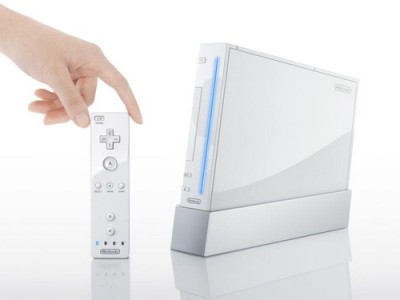
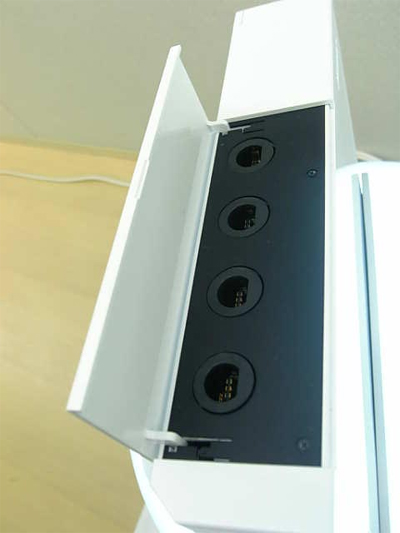
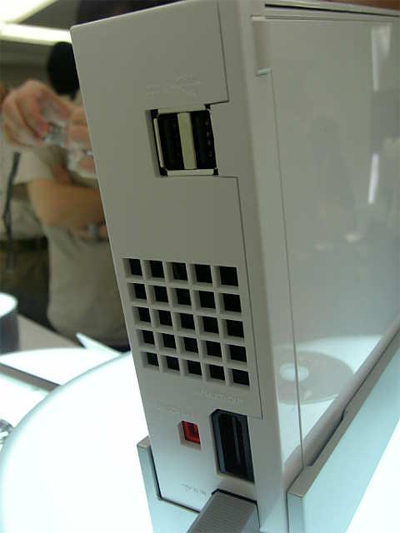
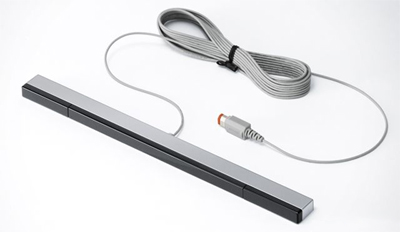
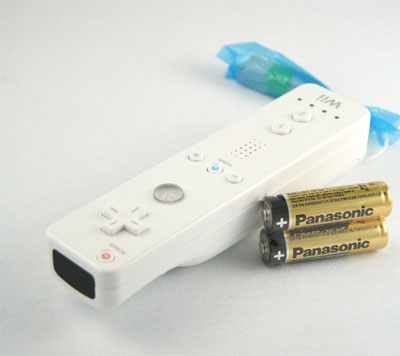
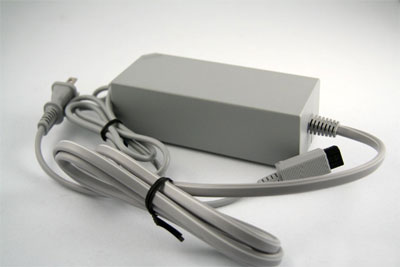
The Wii's design is simple, small, and clean. Size-wise, it's been compared to the size of about 3 DVD cases stacked on top of one another. It can be positioned either sitting flat, like an external DVD drive would next to your computer, or positioned vertically on the included stand. It comes in white, but I've read that they will be releasing them in other colors later on.
It has a single open slot for loading either Wii discs or the smaller Gamecube discs. The slot illuminates a bright blue glow when loading discs and if there is a message waiting for you on your Wii while on standby, but can be turned off if it bothers you. If positioned vertically, the "top" of the Wii has two discreet covers that hide the Gamecube controller ports and the expansion slots for Gamecube memory cards. Right above the disc slot is a small cover which hides the SD card slot.
The Wii is very quiet in its operations. It has some ventilation on the the back and on the underside, but even when the fans kick up, it's works very silently and is easily forgotten once the game has begun.
Besides the aformentioned ventilation grate on the back, there are three connections on the back of the Wii. One is for the sensor bar, which rests either on top of your TV or just below it. The sensor bar is very thin, just bigger than a pencil lying on a table, and is about an inch deep. This is what receives the signals from the Wii remotes, which will be discussed in greater detail later on.
Besides the sensor bar, the A/V cables and power adapter are also plugged into the back. One negative is that the power adapter has a fairly large sized block that you have to find someplace to hide. It's not quite the size of a brick, but it's not far off. Another negative is that the Wii only comes with the standard compositet (red/white/yellow) cables, so if you want to use component cables, you'll have to buy those separately. There are also 2 USB ports on the back, although I'm not sure when they'll be updated via firmware to be operational.
The Wii remote will be discussed in further detail later on.
Overall, I think the system looks great sitting just next to or below the television. I was sort of having reservations of not waiting and maybe getting it in black, but the white is glossy, clean and at the same time inconspicuous. My favorite kind of gadget.
Pictures below courtesy of www.wiisworld.com.






Labels: nerdy, reviews, video games, wii
leave a response